
-
1903 May 27 from corner of Wellington Pl.
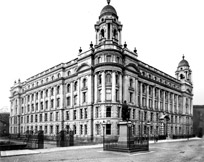
Municipal Technical Institute

1907 Strike at the docks in Belfast
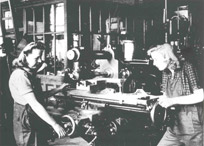
Women munitions workers being trained
in the College May 1942
Military training within the College

Pharmacy students in Morton's Cafe 1954
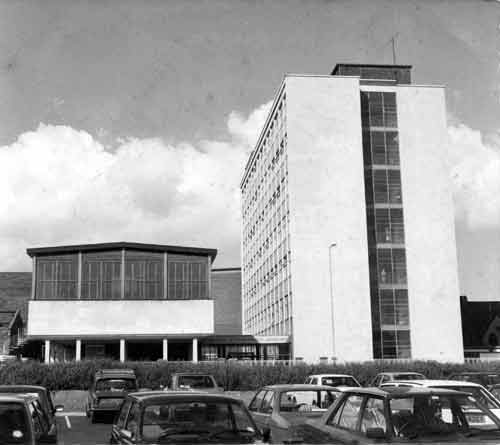
Millfield tower building in the 1960s
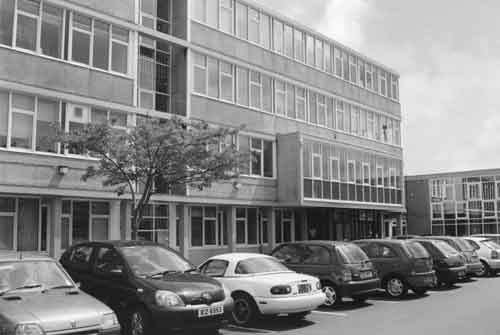
Tower Street building
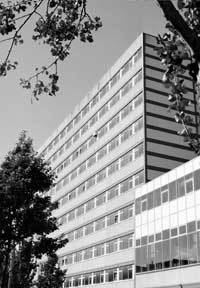
Brunswick Street College
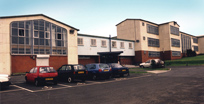
Whiterock campus building
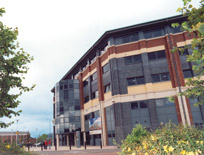
New Gerald Moag Millfield building
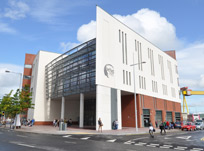
New Titanic Quarter building
1900
Establishment of the Municipal Technical Institution.
11th September 1908
First students into College Square East Building whose opening coincided with a remarkable period of economic and political development. The imposing new building, located at College Square East, was designed to cater for the education and training needs of a major industrial area. Visitors to the building were confronted with nothing less than a secular cathedral that paid homage to the Industrial Revolution, the sciences, arts and crafts. The building also played an important role in contributing to the prosperity and vitality of the city.
30 October 1907
The official opening of CSE also coincided with industrial disputes among Belfast’s unskilled and non-union workers and the rapid growth of the trade un
ion movement in the city. By mid 1907 Belfast was in the grip of a lock-out and a paralysing strike and riots broke out in August of that year. Local industries such as ship building relied upon the institute to educate and train their apprentices in a wide range of skills
1908
Queens college became a separate University under the Irish Universities Act of 1908. The University Commissioners recommended that Queen’s recognise the Institute as a college, with participating professors and lecturers being accepted as extra- mural University staff. This arrangement allowed university students to take courses, or parts of courses, at College Square.
1909
College Square East building extended by adding extra floors to the rear facing Inst and the addition of an extra floor. The new extension housed a Public Textile Testing and Conditioning House, requested by the textile trade employers on D Floor complete with a reception and waiting room. At the top of the building F floor housed a large gymnasium fitted with ‘the most modern appliances’ such as a Danish and Swedish ‘vaulting horse’.
1914
The Municipal Technical Institute was thrown into disruption as war broke out and the college lost large numbers of staff and students. As the war progressed, the government called for a massive increase in munitions production. In response, the Institute set up a special organisation to manufacture war goods; this was later known as the Munitions Department. As the traditional male workforce was depleted by repeated recruitment drives, women were encouraged to train as skilled workers in the art of manufacturing Mills bombs and other deadly weapons of war.
1920
Marked the provision of education through a new state under British rule following the partitioning of Ireland. The first Minister for Education under the new Northern Ireland Government was Lord Londonderry.
April 1921
The College was renamed as the Municipal College of Technology to
bring the College into line with colleges in Great Britain.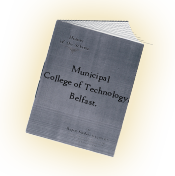
To mark this name change the second Principal Rupert Stanley, documented the history of the college to that point and provided a great insight into the thoughts on education and skills at that time. The booklet
(Click the book to the left for a PDF version)
was printed by ex-service men in one of the ex-services men’s training classes run by the college.
1941
The second World War saw a further change in direction for the College. The Royal Air Force was badly in need of radio mechanics. In November 1941 the College was one of the elite group of colleges throughout the UK chosen to undertake the training of specially chosen RAF students. The college was also once again pressed into service as a munitions factory and, as in the first world war, large numbers of women were recruited for this work.
1949
Adult and community education commenced in Danube Street Working Men’s club off the Crumlin Road. The demand for these courses demonstrated that more such courses were required at a community level throughout Belfast. Consequently courses were delivered in various locations throughout the city as community education flourished.
1950s and 1960s
The local economy was changing and the College of Technology had to develop more flexible programmes to meet the challenges of the new era, symbolised by advances in technology. There was also a rapid growth in service industries demanding greater emphasis on commercial and business education. There was also a demand for new concepts of continuing education, providing adults with the opportunity to gain qualifications that may have been denied to them in school.
By 1951
400 students were enrolled in out-centres throughout Belfast.
1955
The introduction of day release classes which were an instant Success but left long days for the working students often not getting home until near midnight. Trade scholarship schemes were also developed for apprentices who had shown promise in their work in evening classes in specific trade areas. Running alongside these schemes was a Technical Day School which provided secondary education for students from ages twelve to thirteen. The course was intended to run for three years leading onto employment for successful students. A fourth year in the Technical Day School was available for bright students who would go onto take the new GCE examinations enabling them to apply for university entrance or to one of the professional bodies.
Early 1960’s
In the early 1960’s the old technical education system was still very much intact and the maritime courses were booming. The overcrowding problem that was an issue before was once again a problem. Consequently a new building was required to enter the 1960’s with a flourish. The new college was the Millfield Building which towered over the surrounding area.
1960
The Jaffe Centre Cliftonville Road became known as the Belfast ‘b’roo’ school as it provided courses for the young unemployed However, it had also delivered courses from the 1920s to the mid 1970’s.
1964
Saw the opening of a purpose built further education centre in Tower Street, off the Newtownards Road.
May 1965
Official opening of the Tower Street building by Major Rupert Stanley.
1968
Belfast Education Authority report documented that there were 241 classes in various buildings catering for 5000 students. The disparate provision of education was similar to the early 1900’s before the opening of the College Square East Building.
1970
The College of Business Studies opened in Brunswick Street. As the
old industries declined there was greater demand for GCE ‘O’ and
‘A’ Level courses. Three main colleges in Belfast, two with distinct areas of specialism
i.e. the College of Technology and the college of Business Studies.
Rupert Stanley College provided a more general academic
education. The early 1970’s saw a serious decline in enrolments due
to the violence and general disturbances however education
continued throughout the troubles and bomb attacks on the
buildings.
1973
Development of the Belfast Education and Library Board who assumed responsibility for the colleges from the City Council.
1973
Opening of the Ulster Polytechnic in Jordanstown which took one third of the staff from the College of Technology and one department from the college of Business Studies. The traditional industries were in rapid decline.
1974
Rupert Stanley College was responsible for the organising and administration of all adult evening classes throughout the Belfast area. Adult education already provided for by the College of Business Studies and the college of Technology would remain with those colleges.
1978
Rupert Stanley College was offering over 100 subjects in 55 evening centres with a subject enrolment of 16,300 students.
1980’s
Late 1980’s saw the growth in the economy but not of the older industries and trades. The new growth areas were in business and commerce which demanded more flexible patterns of further education with the emphasis on training for higher education and obtaining qualifications to move into employment in a changing workplace. The College of Business Studies was bursting at the seams with huge enrolment figures. The College of Technology was hit hard with the removal of many high level courses to Jordanstown and by the decline in traditional training and education patterns. Provision of education in Belfast needed to be reviewed.
1981
A working party on adult and community education reported to the Belfast Education and Library Board on the scale of courses and programmes on offer and the overlaps in provision between the colleges of further education and the diverse number of supporting agencies. The lack of co-ordination, provision of information, cross- college marketing strategies, clear progression routes through the three colleges signalled a series of recommendations to improve the situation including the establishment of a resource centre to coordinate information and provide a smoother access to further education and the opening of a fourth college.
Mid 1980’s
Rupert Stanley College obtained the use of the former St Thomas School on the Whiterock Road which expanded rapidly and became a community college delivering education and training programmes and adult education drawing students into University access courses. There were also further developments in community education with the development of Willowfield Drive (a centre for the performing arts in east Belfast) and Riddell Centre on the Shankill Road (dealing with youth unemployment in that area).
Early 1990’s
The focus was on long-term unemployment and new programmes were developed including Adult Unemployment Initiatives seeking to encourage the long-term unemployed into vocational courses and an Open Learning scheme in Brunswick Street to promote distance learning to those unable to attend regular classes.
1991
The Chief Officer of the Belfast Education and Library Board Gerald Moag commissioned a report on the provision of further education which recommended the creation of a single new institute.
1 April 1991
Belfast Institute of Further and Higher Education was established. After initial confusion the benefits of a single prospectus, better use of accommodation and the creation of a student services department outweighed initial teething problems.
1995
Introduction of government policy on funding required greater financial management and business controls.
2002
Demolition of the original Millfield complex.
2003
Opening of the new Gerald Moag Millfield complex on the same site.
2007
Further streamlining of further education provision resulted in the merger of BIFHE and Castlereagh College and the establishment of the Belfast Metropolitan College (Belfast Met), one of 6 Colleges in Northern Ireland.
June 2011
In June 2011 as part of its estates strategy, Belfast Met closed the doors of its’ College Square East and Brunswick Street premises.
August 2011
Saw the opening of the College’s flagship campus in Belfast’s Titanic Quarter, a state of the art learning facility and home to one of the key industries (ship building) which helped establish the need for a college to skill future workforces.
Back to Top
